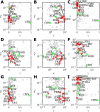Hindsight is 2020 vision: a characterisation of the global response to the COVID-19 pandemic
- PMID: 33287789
- PMCID: PMC7719727
- DOI: 10.1186/s12889-020-09972-z
Hindsight is 2020 vision: a characterisation of the global response to the COVID-19 pandemic
Abstract
Background: The global impact of COVID-19 and the country-specific responses to the pandemic provide an unparalleled opportunity to learn about different patterns of the outbreak and interventions. We model the global pattern of reported COVID-19 cases during the primary response period, with the aim of learning from the past to prepare for the future.
Methods: Using Bayesian methods, we analyse the response to the COVID-19 outbreak for 158 countries for the period 22 January to 9 June 2020. This encompasses the period in which many countries imposed a variety of response measures and initial relaxation strategies. Instead of modelling specific intervention types and timings for each country explicitly, we adopt a stochastic epidemiological model including a feedback mechanism on virus transmission to capture complex nonlinear dynamics arising from continuous changes in community behaviour in response to rising case numbers. We analyse the overall effect of interventions and community responses across diverse regions. This approach mitigates explicit consideration of issues such as period of infectivity and public adherence to government restrictions.
Results: Countries with the largest cumulative case tallies are characterised by a delayed response, whereas countries that avoid substantial community transmission during the period of study responded quickly. Countries that recovered rapidly also have a higher case identification rate and small numbers of undocumented community transmission at the early stages of the outbreak. We also demonstrate that uncertainty in numbers of undocumented infections dramatically impacts the risk of multiple waves. Our approach is also effective at pre-empting potential flare-ups.
Conclusions: We demonstrate the utility of modelling to interpret community behaviour in the early epidemic stages. Two lessons learnt that are important for the future are: i) countries that imposed strict containment measures early in the epidemic fared better with respect to numbers of reported cases; and ii) broader testing is required early in the epidemic to understand the magnitude of undocumented infections and recover rapidly. We conclude that clear patterns of containment are essential prior to relaxation of restrictions and show that modelling can provide insights to this end.
Keywords: Approximate Bayesian computation; COVID-19; SARS-CoV-2; Sequential Monte Carlo; Stochastic epidemiological models.
Conflict of interest statement
The authors declare that they have no competing interests.
Figures






Similar articles
-
The impact of travelling on the COVID-19 infection cases in Germany.BMC Infect Dis. 2022 May 12;22(1):455. doi: 10.1186/s12879-022-07396-1. BMC Infect Dis. 2022. PMID: 35549671 Free PMC article.
-
Modelling the early phase of the Belgian COVID-19 epidemic using a stochastic compartmental model and studying its implied future trajectories.Epidemics. 2021 Jun;35:100449. doi: 10.1016/j.epidem.2021.100449. Epub 2021 Mar 23. Epidemics. 2021. PMID: 33799289 Free PMC article.
-
The Effect of Governmental Health Measures on Public Behaviour During the COVID-19 Pandemic Outbreak.Int J Health Policy Manag. 2022 Oct 19;11(10):2166-2174. doi: 10.34172/ijhpm.2021.131. Epub 2021 Sep 11. Int J Health Policy Manag. 2022. PMID: 34814663 Free PMC article.
-
Battling COVID-19 pandemic waves in six South-East Asian countries: A real-time consensus review.Med J Malaysia. 2020 Nov;75(6):613-625. Med J Malaysia. 2020. PMID: 33219168 Review.
-
Institutional and behaviour-change interventions to support COVID-19 public health measures: a review by the Lancet Commission Task Force on public health measures to suppress the pandemic.Int Health. 2021 Sep 3;13(5):399-409. doi: 10.1093/inthealth/ihab022. Int Health. 2021. PMID: 33974687 Free PMC article. Review.
Cited by
-
The race to understand immunopathology in COVID-19: Perspectives on the impact of quantitative approaches to understand within-host interactions.Immunoinformatics (Amst). 2023 Mar;9:100021. doi: 10.1016/j.immuno.2023.100021. Epub 2023 Jan 8. Immunoinformatics (Amst). 2023. PMID: 36643886 Free PMC article. Review.
-
Tools and Techniques for Severe Acute Respiratory Syndrome Coronavirus 2 (SARS-CoV-2)/COVID-19 Detection.Clin Microbiol Rev. 2021 May 12;34(3):e00228-20. doi: 10.1128/CMR.00228-20. Print 2021 Jun 16. Clin Microbiol Rev. 2021. PMID: 33980687 Free PMC article. Review.
-
Explainability of the COVID-19 epidemiological model with nonnegative tensor factorization.Int J Data Sci Anal. 2023;15(3):267-280. doi: 10.1007/s41060-022-00324-1. Epub 2022 Apr 30. Int J Data Sci Anal. 2023. PMID: 35528806 Free PMC article.
-
Simple discrete-time self-exciting models can describe complex dynamic processes: A case study of COVID-19.PLoS One. 2021 Apr 9;16(4):e0250015. doi: 10.1371/journal.pone.0250015. eCollection 2021. PLoS One. 2021. PMID: 33836020 Free PMC article.
-
Framework for assessing and easing global COVID-19 travel restrictions.Sci Rep. 2022 Apr 28;12(1):6985. doi: 10.1038/s41598-022-10678-y. Sci Rep. 2022. PMID: 35484268 Free PMC article.
References
-
- Johns Hopkins Univeristy. Coronavirus resource center. https://coronavirus.jhu.edu/. Accessed 25 July 2020.
-
- Ritchie H, Ortiz-Ospina E, Roser M, Hasell J. COVID-19 deaths and cases: how do sources compare? Our World in Data. 2020. https://ourworldindata.org/covid-sources-comparison. Accessed 10 June 2020.
-
- European Centre for Disease Prevention and Control. COVID-19. https://qap.ecdc.europa.eu/public/extensions/COVID-19/COVID-19.html. Accessed 10 July 2020.
MeSH terms
Grants and funding
LinkOut - more resources
Full Text Sources
Medical
Miscellaneous

